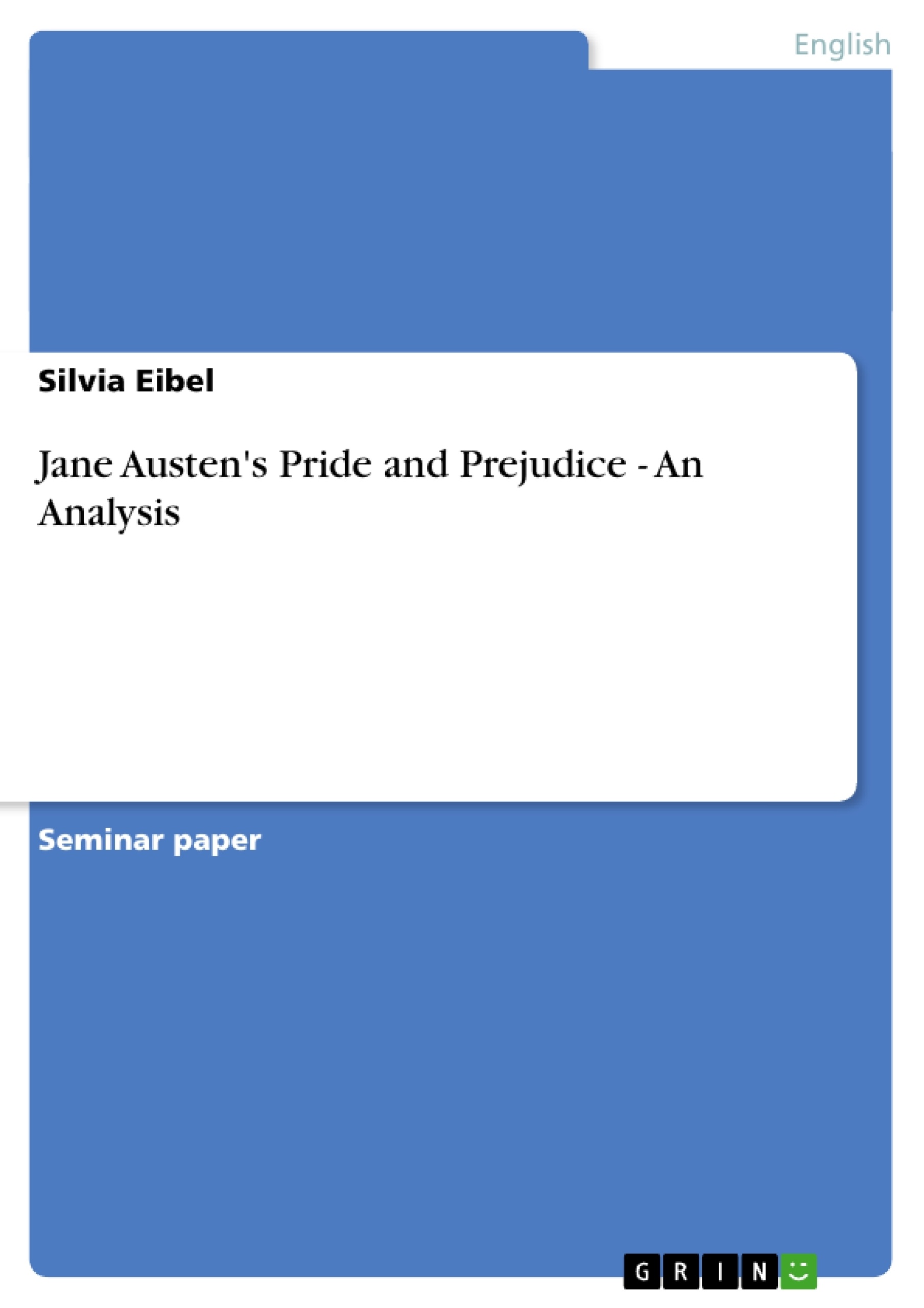Pride and Prejudice is set primarily in the town of Hertfordshire, about 50 miles outside of London in the 19th century. The two most important places are Longbourn (residence of the Bennet family) and Netherfield Park (residence of the Bingleys). These two places are mentioned right at the beginning when Mrs. Bennet says: “[...] Mrs. Long says that Netherfield is taken by a young man of large fortune from the north of England; that he came down on Monday in a chaise of four [...]” (PP, 5) The residence of the Bennets is first mentioned in the third chapter of the first volume when it says “[...]They returned therefore in good spirits to Longbourn, the village where they lived, and of which they were the principal inhabitants. [...]” (PP, 13)
Table of content
1. Story level
1.1. Setting
1.2. Action
1.3. Characters
2. Discourse level
2.1. Narrative situation
3. References
1. Story Level
1.1. Setting
Pride and Prejudice is set primarily in the town of Hertfordshire, about 50 miles outside of London in the 19th century. The two most important places are Longbourn (residence of the Bennet family) and Netherfield Park (residence of the Bingleys). These two places are mentioned right at the beginning when Mrs. Bennet says: “[...] Mrs. Long says that Netherfield is taken by a young man of large fortune from the north of England; that he came down on Monday in a chaise of four [...]” (PP, 5)
The residence of the Bennets is first mentioned in the third chapter of the first volume when it says “[...]They returned therefore in good spirits to Longbourn, the village where they lived, and of which they were the principal inhabitants. [...]” (PP, 13)
1.2. Action
Pride and Prejudice is the story of Mr. and Mrs. Bennet, their five daughters, and the various romantic adventures at their Hertfordshire residence of Longbourn. The parents' characters are greatly contrasted: Mr. Bennet is a wise and witty gentleman; while Mrs Bennet is permanently distracted by the issue of marrying off her daughters at any cost. The reason for Mrs Bennet's obsession is that their estate will pass by law after Mr Bennet's death to his closest blood relative: his cousin, the Reverend William Collins.
Austen's tale is speeded up by the arrival of the young and wealthy bachelor Charles Bingley and his friend Fitzwilliam Darcy. It is the story of the various affections, affectations and engagement impostures that develop because of Mrs. Bennet's implacable matchmaking and Darcy's turbulent relationship with Elizabeth Bennet.
1.3. Characters
Character is an expression of what people value. Social character expresses the values of the current society. Pride and Prejudice occurs at a time when traditional ideas about status start to give way to money as the dominant value in society.
By reading the novel the reader gets to know that Dary chose Elizabeth for her character and not for her money or status. For him social status was the primary value. So it was basically the low behaviour of her family and the class status that deterred him. Finally, all the values of status and social class do not play a role anymore and he married Elizabeth because of her character.
Throughout the novel the reader can distinguish several types of characters. The major characters are of course Elizabeth and Darcy as well as Jane and Mr. Bingley. Austen created two couples with big differences and the most interesting thing is how these two couples interact.
The appearance of Jane and Elizabeth is totally different. Elizabeth exhibits an overflowing energy of mental alertness, quickness and is disposed to mirth. She has great personal strength, which increases in adversity. In contrast to her “strong” character, Jane has little energy. She is mild, meek and easily depressed by disappointment.
The same differences the reader notices between Darcy and Mr. Bingley. Darcy is strong, selfish and acts with determination. Compared to him, Bingley is mild and somehow decent like Jane, with no strong opinions or convictions of his own.
In every novel we can difference flat and round characters. . Flat characters are, according to Forster, what was previously described as “types” or “caricatures” and they built around a single idea or quality. Such a person can be represented by a unique sentence, a label. There is no development with them, they are two-dimensional and highly predictable and never changed by circumstances. In novels their function is highly conspicuous, especially for the sake of contrast. (Aspects of the Novel: 1970: 87)
Jane and Bingley are good examples for flat characters. They do not go through any development and are presented highly predictable. The reader gets to know from the very beginning that they would belong together because they are so similar.
On the contrary, Forster says that round characters are complex multidimensional and unpredictable. Only this kind of characters can really be tragic and can move us, arousing various feelings. The test for a round character is his or her capacity or surprising the reader convincingly.
As Jane and Bingley are flat characters, Elizabeth and Darcy are exactly the opposite. Both are unpredictable and make the novel tragic and through this behaviour they attract the reader’s attention.
[...]
- Citar trabajo
- Silvia Eibel (Autor), 2004, Jane Austen's Pride and Prejudice - An Analysis, Múnich, GRIN Verlag, https://www.grin.com/document/36448
-

-

-

-
¡Carge sus propios textos! Gane dinero y un iPhone X. -

-
¡Carge sus propios textos! Gane dinero y un iPhone X. -

-
¡Carge sus propios textos! Gane dinero y un iPhone X. -

-
¡Carge sus propios textos! Gane dinero y un iPhone X. -

-
¡Carge sus propios textos! Gane dinero y un iPhone X.

